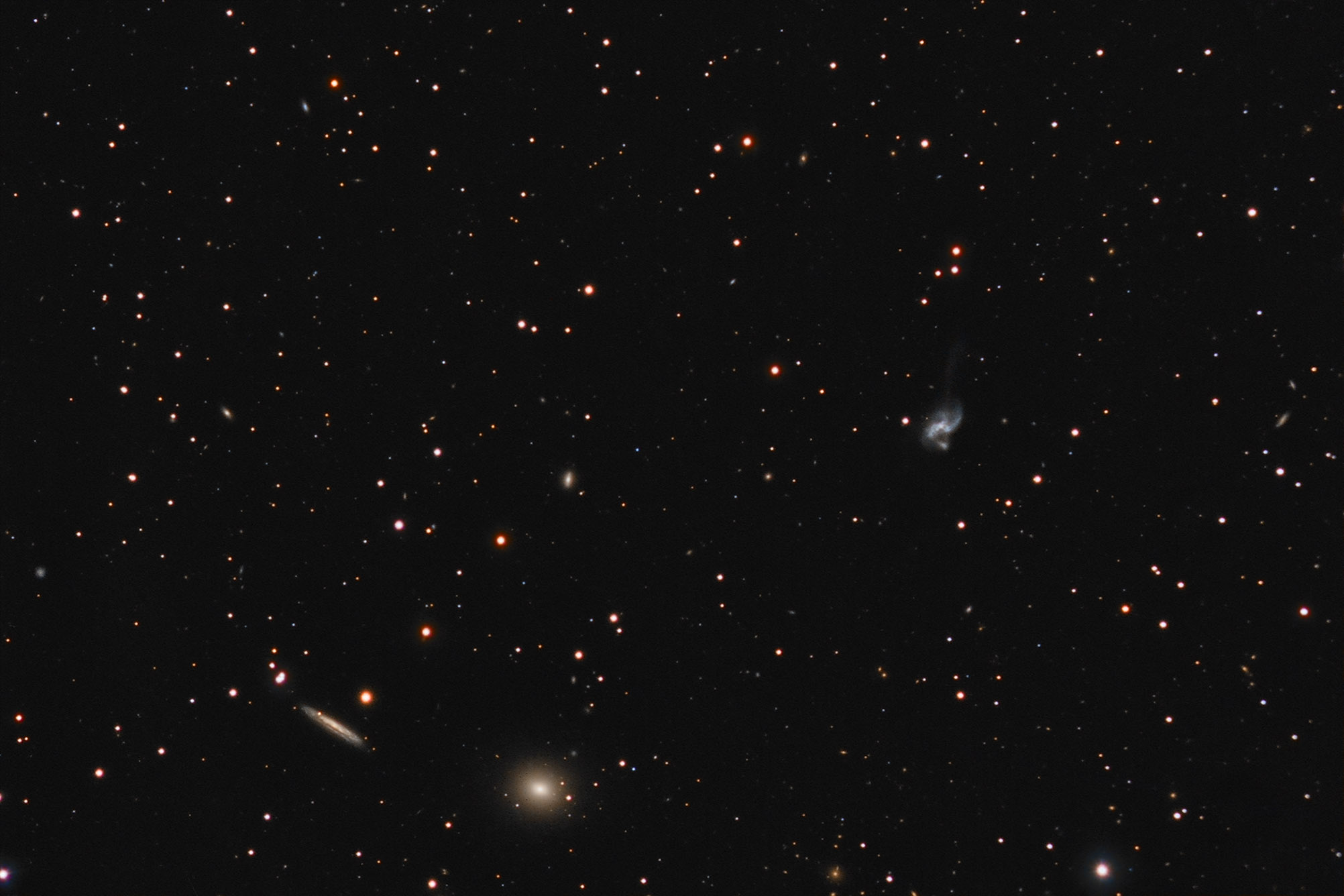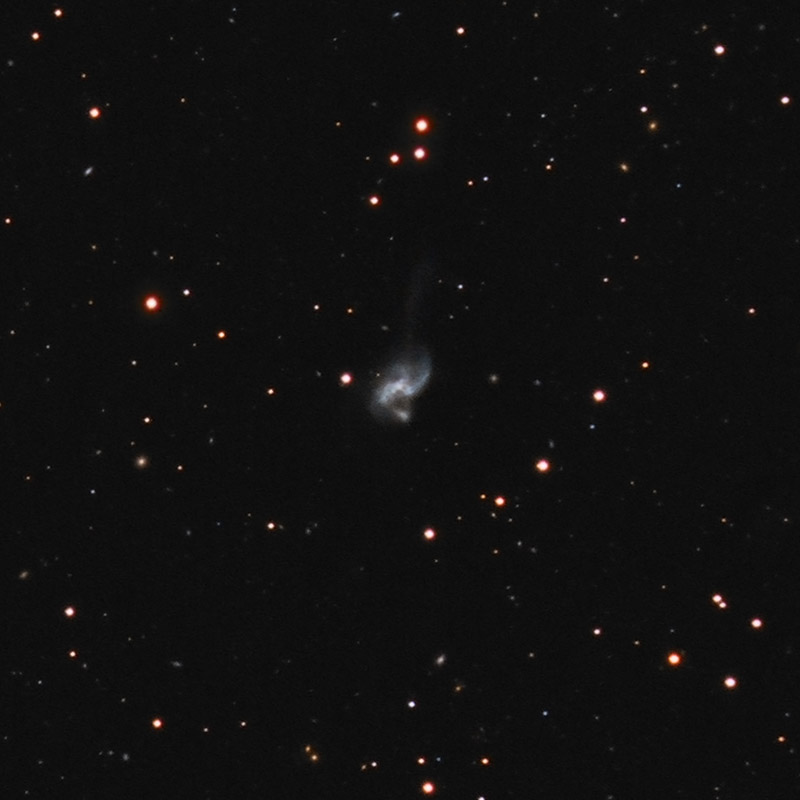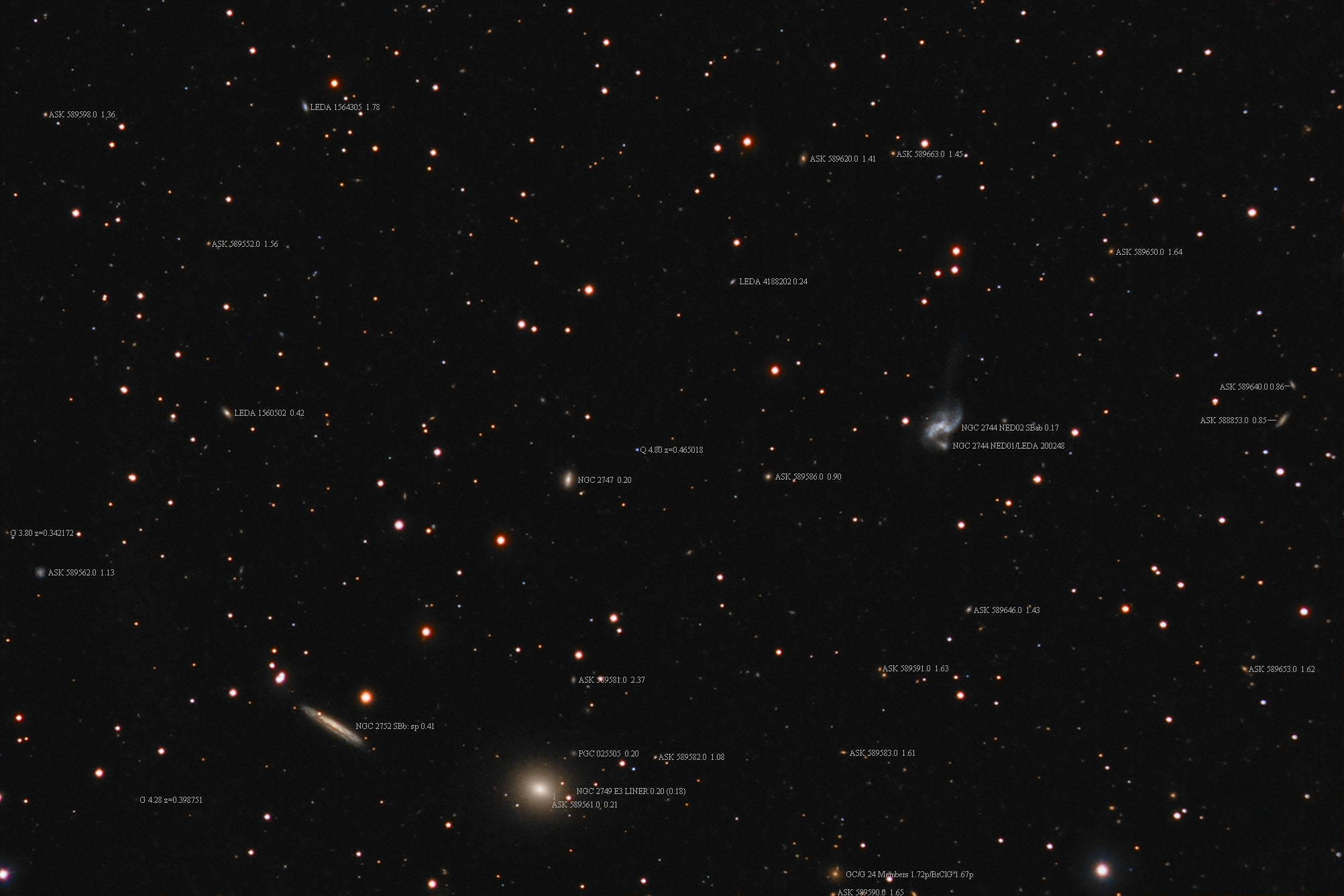| Description | Images |
Object name: NGC2744Designation(s): NGC2744, NGC2747, NGC2749, NGC2752, NGC 2744 is the strange galaxy in the NGC 2749 galaxy group which is located in Cancer the crab. It certainly is a train wreck of a galaxy. It is often considered a double galaxy. The southern part is also known as LEDA 200248. Is it a separate galaxy or part of the mess that is NGC 2744? Seligman considers it the latter. It is obvious something collided with what was a normal spiral galaxy. Is the southern piece the offending galaxy. If not what happened to the colliding galaxy? I find no other candidates. The north going plume may be stars ripped from the colliding galaxy and the southern blob what is left of it -- or not. I find no studies of star rotation in the main galaxy. If it has digested the colliding galaxy it should show in a study of the motion of the disk stars. But I find this one has been mostly ignored since 1985 with most papers only discussing its visual appearance and debating if the southern part is a companion or not. Until more to the contrary, I vote that the southern blob is likely the remains of a colliding galaxy. I say this as to my eye the north plume passes behind the northern galaxy then reappears below it much brighter and joins the lower blob. If so that shows the lower blob to be the most likely source of the plume, probably showing its path to the train wreck. In any case, it will eventually become part of the galaxy which will likely retain its spiral nature. Like many of the NGC galaxies, it was discovered by William Herschel on March 21, 1784. It isn't in either of the H400 observing programs. Related Designation(s):2MASS J09051835+1826320, 2MASS J09052132+1818471, 2MASS J09054307+1820226, 2MASX J09051836+1826322, 2MASX J09052131+1818472, 2MASX J09054305+1820226, 2MASX J09054355+1820276, 2MASXi J0905183+182632, 2MASXi J0905214+181850, 2MASXi J0905427+182020, 2MFGC 07082, AKARI J0904388+182748, ASK 589556.0, ASK 589564.0, CGCG 090-065, CGCG 090-069, CGCG 090-070, CGCG 090-072, CGCG 0901.8+1839, CGCG 0902.5+1830, CGCG 0902.5+1838, CGCG 0902.9+1832, ECO 02343, ECO 02563, GALEXASC J090518.34+182631.3 , GALEXASC J090521.22+181846.9 , GALEXMSC J090518.36+182632.1 , GALEXMSC J090521.19+181847.2 , IRAS 09018+1839, IRAS 09028+1832, IRAS F09018+1839, IRAS F09029+1832, KIG 0302:[VOV2007] 029, LDCE 0613 NED002, LGG 166:[G93] 001, LGG 166:[G93] 005, MCG +03-23-031, MCG +03-23-036, MCG +03-23-038, NGC 2744, NGC 2747, NGC 2749, NGC 2752, NGC2744, NGC2747, NGC2749, NGC2752, NPM1G +18.0220, NSA 105734, NSA 157029, NSA 157031, NVSS J090521+181847, NVSS J090542+182020, PGC 025480, PGC 025507, PGC 025508, PGC 025523, SDSS J090518.33+182631.9, SDSS J090518.34+182631.9, SDSS J090543.02+182022.9, SDSS J090543.03+182023.0, SDSS J090543.05+182023.0, UGC 04757, UGC 04763, UGC 04772, USGC U203 NED05, USGC U203 NED06, USGC U203 NED08, UZC J090518.3+182631, UZC J090521.4+181848, UZC J090543.1+182024, UZC-BGP 20B, UZC-CG 087 NED03, UZC-CG 087 NED04, UZC-CG 087 NED06, v2MCG 30:[DMP2012] 1, v2MCG 30:[DMP2012] 5, VV 612, WBL 202-002, WBL 202-003, WBL 202-005, WBL 205:[HIV2012] 0178, WBL 210:[HIV2012] 0009, WBL 213:[HIV2012] 0076, [DZ2015] 642-01, [DZ2015] 642-04, [HIV2012] 2034, [HIV2012] 3095, [HIV2012] 3753, [TTL2012] 410256, [TTL2012] 410945, | Permanent link: https://images.mantrapskies.com/catalog/NGC/NGC2744-NGC2747-NGC2749-NGC2752/NGC2744L6X10RGB2X10.JPG |


